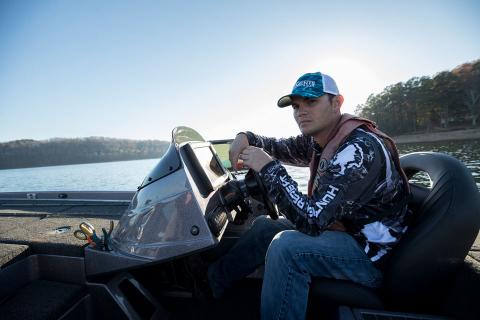Mossy Oak ProStaff Regional Director D.J. Randolph of Velva, North Dakota, has been hunting antelope with a bow for 15 years.
Where to Hunt Antelope
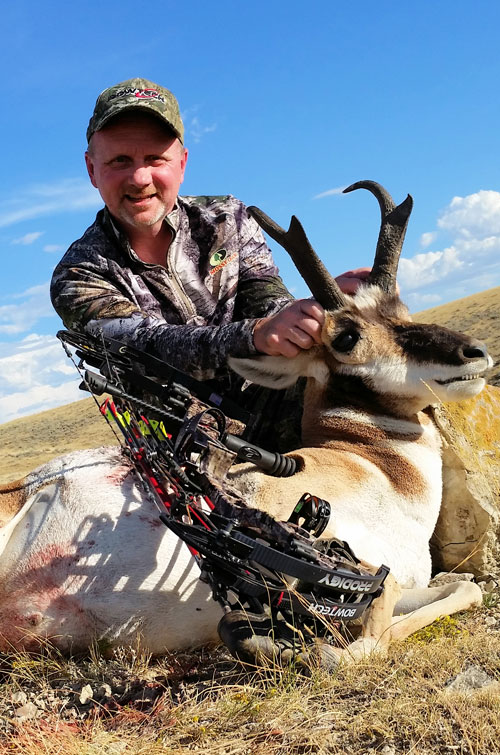 If you’re planning to hunt antelope, you have to find the land you’re going to hunt first. A lot of the big ranches that issue trespass licenses will be booked up a year or two in advance, so your chances of driving to a western state, going to a property where you have seen antelope, expecting to pay a trespass fee and hunting those antelope are pretty slim. If you want to do a private-land hunt, you need to make those arrangements well in advance of when you plan to arrive. If you’re hunting public lands, remember that when you get out into that open prairie land, the land all looks the same. Some of that land is easily accessible from public roads, and some of that land is much harder to access. Knowing as much as you can about the land you want to hunt and planning ahead of time really can pay off for your success.
If you’re planning to hunt antelope, you have to find the land you’re going to hunt first. A lot of the big ranches that issue trespass licenses will be booked up a year or two in advance, so your chances of driving to a western state, going to a property where you have seen antelope, expecting to pay a trespass fee and hunting those antelope are pretty slim. If you want to do a private-land hunt, you need to make those arrangements well in advance of when you plan to arrive. If you’re hunting public lands, remember that when you get out into that open prairie land, the land all looks the same. Some of that land is easily accessible from public roads, and some of that land is much harder to access. Knowing as much as you can about the land you want to hunt and planning ahead of time really can pay off for your success.
Online mapping sources are the best way to see and learn the land before you get there. I use onX maps, and I think they are excellent because they show you the private-land and the public-land boundaries, too. You can download those maps to your SmartPhone. I use OnX maps every day I'm hunting antelope. You also will need a quality pair of binoculars because most of the glassing that you’ll do is from a truck. With a good pair of binoculars or a spotting scope, you often can see for 2-3 miles in many areas. The onX maps will allow you to know whether you can legally hunt those animals, if you’re hunting public land. You also can watch the antelope and more or less determine the direction of travel they’re taking. You may be able to spot some water sources, dry creek beds you can stalk through or some slightly rolling hills you can use to conduct a stalk. For instance, if the herd is moving north to south, then begin to study the terrain to see what type of terrain and where that terrain is located to allow you to get close enough to the antelope to get a shot.
If you see a water hole with antelope nearby, look at terrain, and decide if you can get in close enough to that water hole to set up a blind. If so, then that may be the tactic to use to try to bag your buck. Even if you spook the antelope as you’re taking your blind to the water hole, still go to the water hole, and set up your blind. Usually antelope will forget about you within a couple of hours, if they’re a half mile or a mile away from the water hole when they spot you.
When planning a private-land hunt, you should start within six months to a year before to find land to hunt the following year. If you’re planning a public-land hunt, you need to choose the state and the area in that state that you want to hunt and then apply for your tags in the spring before a late summer or fall hunt.
Once you know the area where you’ll be hunting, then get aerial photography and topographical maps of the region you’ll be hunting. I use Google Maps and Google Earth for aerial photography and onX maps for the specific areas I have to hunt. I can’t image hunting without maps.
If you’re hunting on private lands, plan a 3-4 day hunt. If you’re hunting public lands, plan a 5-7 day hunt. Generally taking a couple of days to get the lay of the land to learn what the antelope on that land are doing consistently is very important to your success. I can't emphasize enough that spending a lot of time glassing to learn the lay of the land and the movement patterns of the antelope on that land is more important to your success than your stalk or setting-up the blind at a water hole. The hours you spend glassing will prevent you from making mistakes you will make, if you haven’t spent time glassing.
To put it simply, success in taking an antelope with a bow is most often knowing what those antelope want to do, where they want to go, and what time of day they want to get there - sometimes before the antelope knows what they’re doing.
Bow Hunting Antelope
I saw there were a lot antelope here in Velva, North Dakota, where I live. I love hunting with a bow, so I decided to try and take an antelope with my bow. I cut my teeth on North Dakota antelope, but because our herd has been down the past few years, I’ve been going to Wyoming the last six years. I hunt both public and private lands. I believe some of the best land for elk hunting will be central Wyoming where there’s an abundance of Bureau of Land Management land - public lands you can hunt - and state lands. Some areas are tough to draw a tag to hunt, but in other places drawing a tag is easy. You can find exceptional antelope hunting anywhere in Wyoming, but the tags that are harder to draw are usually where you will find more quality animals. About half of the animals I've taken have been while sitting in a blind, hunting over a water hole. Even though bagging an antelope with a bow isn’t that hard, you’ll need a double handful of patience and two double handfuls of endurance.
Setting up a blind in extremely hot weather and waiting on an antelope to show up can test the mettle of a bowhunter. While sitting in a blind in central Wyoming, the temperatures at the first of antelope season will be from 85 to 100 degrees in the middle of the day. Of course, if you’re sitting in a blind, the temperatures can be anywhere from 120 to 130 degrees inside that blind.
Most of the regions are really wide open, so you often can see the antelope coming from a long way off. That’s generally when we will turn on our Ozonics odor killer. We can't leave it on all the time because we’ll run the batteries down. But antelope aren’t spooked by human odor nearly as much as whitetails, elk or mule deer. Although antelopes are probably the most tolerant of human odor, antelope tolerance of human odor is dependent on how much hunting pressure the antelopes have had - especially on public lands where the only time they see people is when they are being hunted. On private lands where the antelope are accustomed to seeing the ranch truck, people riding four wheelers and hearing people working on that private ground, they are much more tolerant of human odor than the public-land antelope are. How much human odor an antelope can tolerate without being spooked is really dependent on how much those animals associate human odor with danger.
There are two ways to acquire private land to hunt antelope on: the old fashioned way of knocking on doors and asking for permission or paying a trespass fee to the landowner. For that trespass fee, the landowner will give you permission to hunt antelopes on a certain portion of his land for a specified number of days. That access fee does not include a guide. Depending on the quality of animals on the property, you may pay as little $300 or as much as $800 to hunt 3-4 days on the property that the landowner designates.
Stalking Antelope with a Bow
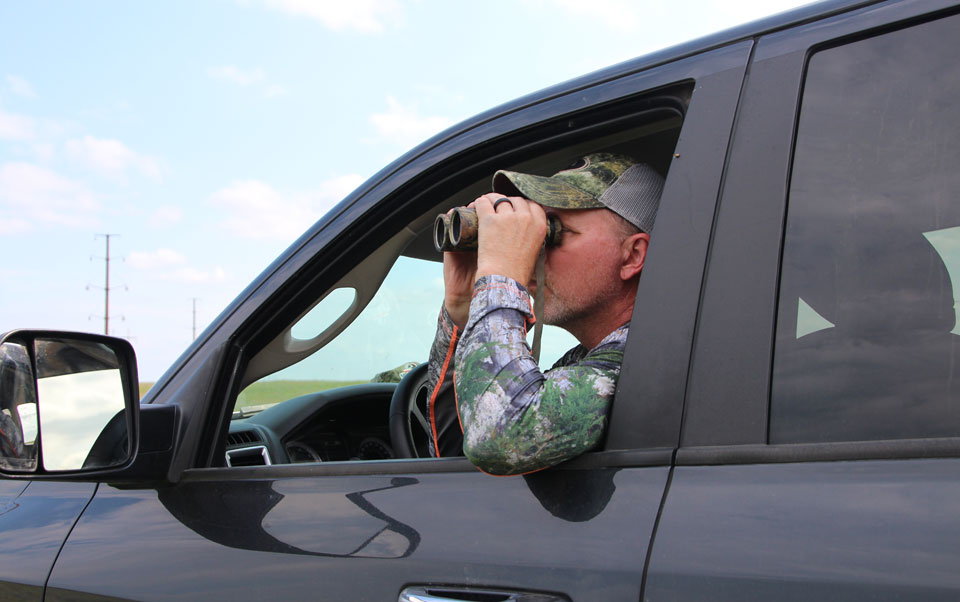
The range you have to shoot can be an advantage or a disadvantage for stalk hunting antelope with a bow. Typically, if you’re going to stalk hunt antelopes, you’ll set up on a high overlook that allows you to see a vast amount of antelope range. Antelopes prefer very flat land usually without very many geographical features, so sometimes you may have to glass hunt for hours until the antelopes move into some type of terrain where you feel comfortable making a stalk. The words, “stalk in antelope country,” may be better described as crawling rather than walking. Sometimes you can get lucky and find a dry creek bed that you can get into and use to slip up on an antelope, but most often you will be crawling on your hands and knees to get close enough to take a bow shot.
Several years ago, I spotted a herd of antelope out in an alfalfa field where the alfalfa had been baled-up. I spent a couple of hours crawling on hands and knees to get from one bale of alfalfa to the next bale. I probably crawled about 300 yards before I could get within bow range. Back then I was wearing Mossy Oak Brush. Since there was a little bit of a roll in the terrain, when I was on my hands and knees and sometimes my stomach, I was able to crawl from bale to bale - without the antelope seeing. I got to within 30 yards of the antelopes. When I finally peeked around a bale, I was surprised to see how close the antelopes were to the bale I was behind. I pulled my rangefinder up to my eyes and saw that the buck I wanted to take was only 28 yards away. I got behind the bale, drew my bow back to full draw and then slowly leaned out from behind the bale until I had a clear shot.
Antelope aren’t generally as spooky as whitetails are. They’re more curious also, so when I leaned out from behind the bale of alfalfa, the buck stood and looked at me to try to determine what I was. That was when I had the opportunity to release the arrow. I shoot a Bowtech bow, and the last few antelope I’ve harvested have been with a Rage broadhead.
The Rutting Antelope Buck
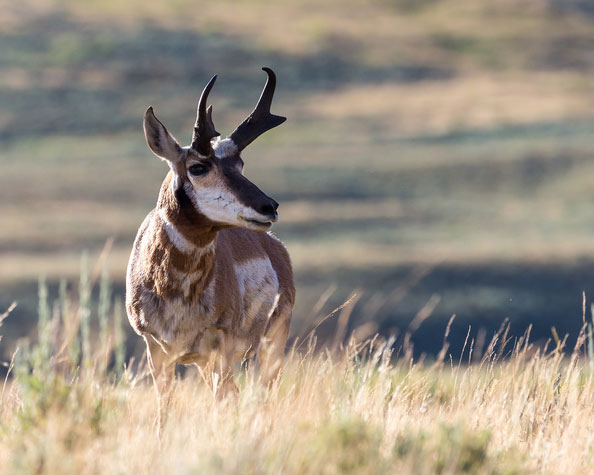 Last year, I found a buck I wanted to take from public lands in Wyoming. I was hunting mule deer and antelope at the same time. Although I was focusing my hunt on mule deer, I also knew that this land had antelopes on it. This was the third day of my hunt, and the antelope had begun to rut.
Last year, I found a buck I wanted to take from public lands in Wyoming. I was hunting mule deer and antelope at the same time. Although I was focusing my hunt on mule deer, I also knew that this land had antelopes on it. This was the third day of my hunt, and the antelope had begun to rut.
When antelope are rutting, the herd buck’s main concern is to keep those does with him and keep all other bucks away from his harem. As I watched, I noticed that the buck in this herd kept his eyes on every doe. When one of his girlfriends started meandering too far away from the herd, he would round her up and force her back into his herd. The first day I stalked this herd, I was able to get in close to the buck by stalking through a dry creek bed. I was below the antelope’s sight. I was able to get in close, but the does saw me as I peeked over the creek bed. However, the buck didn’t spot me, and the does actually started trying to run away from me. So, when the buck saw does running away, his first instinct was to herd those does back into his harem. The buck kept trying to herd the does that had seen me with the other does that were still grouped-up. In the mayhem of the buck frantically trying to round his girlfriends up, I was able to stay low, move through the creek bed and get closer to the main group of does. Because the buck was standing still and so focused on the does, I could ease my head up over the creek bank and use my range finder to determine that the buck was at 55 yards.
At that point, the buck might have seen me, but he didn’t recognize that I was a hunter. My background (the other side of the creek) consisted of clay and sagebrush, and I was wearing Mossy Oak Break-Up Country. I blended in with the terrain. I bent over, nocked an arrow, drew my bow, slowly came up over the edge of the creek bank and took the shot. Although a 55-yard shot might seem a little long to eastern bowhunters, I practice shooting consistently at 80 yards. I wouldn’t advise anyone to take a shot that they are not comfortable shooting, however, I am really comfortable at shooting 50-60 yards. Another reason I took the shot was I didn’t have a 20- or a 30-mile crosswind like you often may have when you hunt antelopes in really open areas. If the buck hadn’t presented a great broadside shot, but instead had been standing at a wrong angle for me to make a lethal hit, I wouldn’t have taken the shot.
Oftentimes when you stalk-hunt antelope you may spend a long time walking bent over or crawling. Then when you get close enough to take the shot, you may have to back out because the buck is at a bad angle, or the wind is blowing too hard to ensure a lethal hit. But on this day the wind wasn’t too bad, and the buck was slightly quartering away from me. I was able to range him, come up and make a clean shot. The buck went only 60 yards before he went down.
Field Dressing Your Antelope
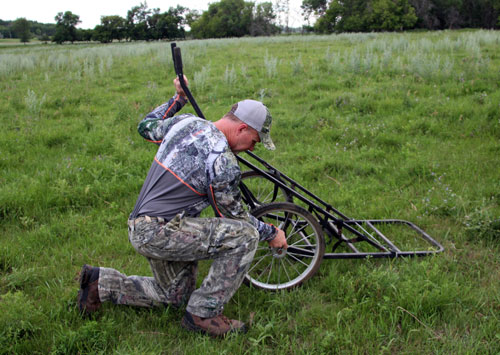 Antelope meat is delicious. My family prefers to eat antelope rather than any other wild game meat. Often you will be hunting on a sunny day with an air temperature of 90 degrees, and if you’re out in the middle of the desert when you take your antelope, your main concern has to be how you can butcher that animal quickly and get that antelope meat cooled down as fast as possible. If I am less than a half mile from where I’ve parked my vehicle, I will walk at the quick step back to my truck where I’ll have a little cart and all my tools (knives, saws and other equipment for butchering). I’ll take the cart and roll the antelope back to the truck to begin the butchering process and getting the meat on ice. If you don’t have a cart, and your truck’s not nearby, you need to have some knives and game bags with you and plan to butcher your animal in the field after taking a few pictures.
Antelope meat is delicious. My family prefers to eat antelope rather than any other wild game meat. Often you will be hunting on a sunny day with an air temperature of 90 degrees, and if you’re out in the middle of the desert when you take your antelope, your main concern has to be how you can butcher that animal quickly and get that antelope meat cooled down as fast as possible. If I am less than a half mile from where I’ve parked my vehicle, I will walk at the quick step back to my truck where I’ll have a little cart and all my tools (knives, saws and other equipment for butchering). I’ll take the cart and roll the antelope back to the truck to begin the butchering process and getting the meat on ice. If you don’t have a cart, and your truck’s not nearby, you need to have some knives and game bags with you and plan to butcher your animal in the field after taking a few pictures.
I have learned that to have really delicious antelope meat to eat, you must get that meat in a cooler on ice within an hour or less after the antelope is down. So, I will debone the meat and put it in game bags. If I’m at the truck, I’ll put the meat in 5-gallon Ziploc bags, force the air out of the tops of the bag, zip the bags shut and put the meat in the cooler with ice and ice water. I usually carry two large coolers with me in the back of my truck. One of the coolers holds my food, water and sports drinks. The other 70-gallon cooler will have only ice in it. I’ll pack the cooler with ice as tightly as I can, so hopefully that ice will last for 3-4 days. By days 3 or 4 of your hunt, half of the ice in the meat cooler may have melted. But you’ll have ice and ice water to put in your Ziploc bags with meat in them. Once again, the quicker you can cool the meat off, the better the taste of the meat will be. I usually can get all the antelope meat in one large bag and put the head in another bag.
A ready cooler and cart are just a few things you’ll need for your antelope hunt. But antelope hunting gear is more extensive than that. Consider pop-up blinds, backpacks, plenty of water and other necessities that will help you have a successful and comfortable hunt.














